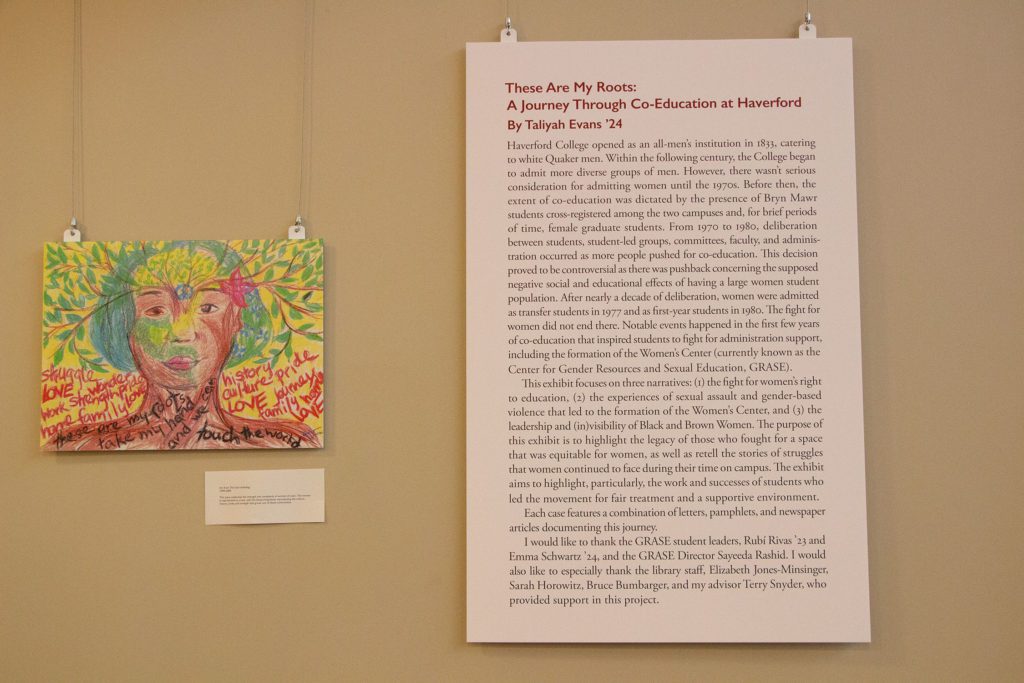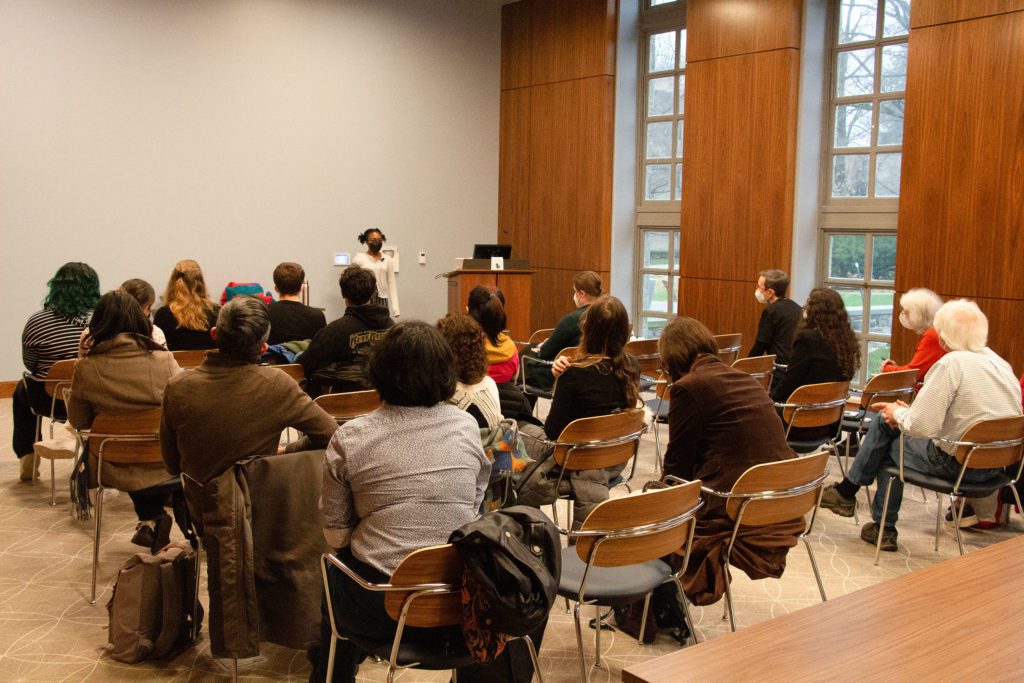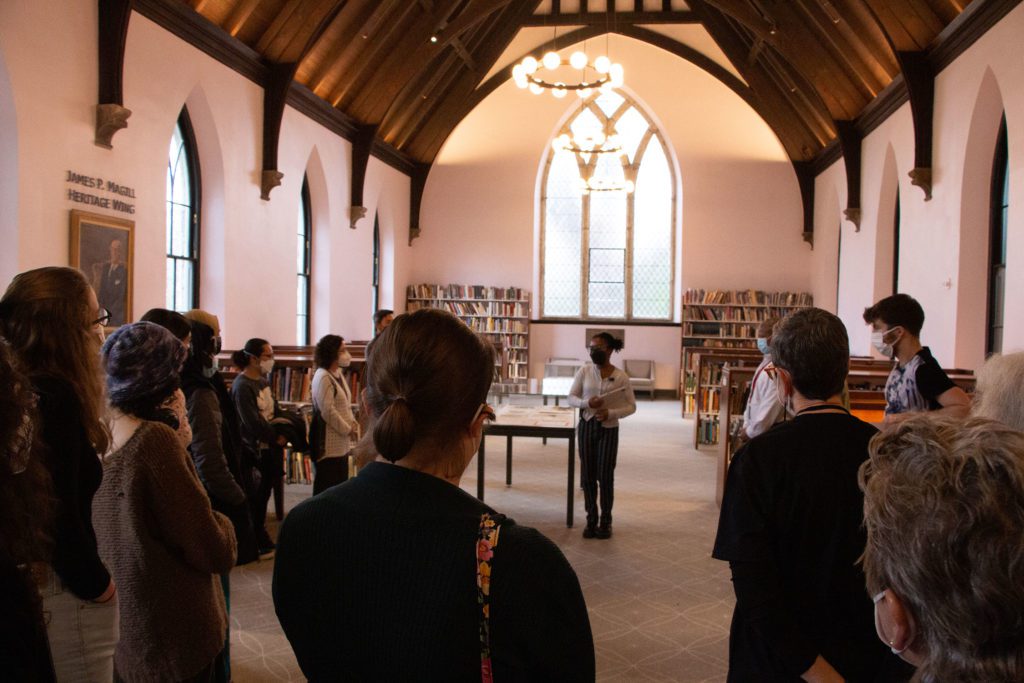It took almost 150 years for women to be accepted as first-year students at Haverford College. Although women had been on campus by special consideration—as graduate students or transfers or Bryn Mawrters who roomed at Haverford—it wasn’t until 1980 that a class of Haverford first-years included women. That population has grown over the last 42 years—currently more than half of Haverford students identify as female. For sophomore Taliyah Evans, this gender shift was a topic of inquiry and spurred her to ask, “How did we even get here in the first place?”
As a student worker in both the libraries and the Center for Gender Resources and Sexual Education (GRASE) simultaneously last year, Evans was perfectly positioned to find the answer. She gathered the fruits of her labor in a new exhibit in two spaces in Lutnick Library (both the Wall Exhibit Space and the James P. Magill Heritage Wing), which debuted for Women’s History Month in March and ran through the end of April.
Evans worked with Sayeeda Rashid, director of GRASE, and Elizabeth Jones-Minsinger, archivist and records manager for the libraries, to curate These Are My Roots: A Journey Through Co-Education at Haverford. The exhibit starts with artifacts that document Haverford’s first co-ed class from outside newspapers as well as internal sources, such as The Bi-Co News, and then transitions to featuring testimonies from women of color.
The exhibit gathers writing and art from an array of campus publications, including The Color Anthology and For My Sisters, anthologies during the 1980s and 1990s, to highlight experiences of women and students of color at Haverford, as well newspaper clippings from The Bi-Co News and The Philadelphia Inquirer. Poetry, artwork, newspaper clippings, and pamphlets help create a historical narrative about the fight for co-education at Haverford, the stories of women of color, and sexual assault on campus.
“[Taliyah] is deeply invested in the experiences of women of color on this campus,” said Rashid, and so the exhibit devotes one display case and wall space to the experience of women of color. The wall space includes the poem “Caramel,” written by an anonymous student, expressing someone’s sense of shame around her skin color. Near this poem is an untitled drawing made by a student that depicts a woman of color as a tree with words labeling her experience scattered across the leaves and the trunk. The display case features an excerpt from The Color Anthology, a collection of students’ experiences as people of color at Haverford, written by Theresa Tensuan ‘89, current advising dean, that expresses her experience being tokenized and the importance of her intersectional identities as a woman and a person of color. Next to this is a piece written by Andrea R. Morris ’91, alum and former professor, that shares how she, as a Black woman, has felt misunderstood by the white community at Haverford.
“The intersection of identities as women and people of color isn’t often recognized, and l feel like that’s still relevant today,” said Evans. “Our experiences are different from white women especially at a predominately white institution, where a lot of people may not hear or understand those stories.”
“[Taliyah] really pulled these narratives [together] in a way that’s really engaging,” said Jones-Minsinger.
In one display case focused on the road to coeducation, Evans presents newspaper clipping documenting Haverford’s first co-ed class as well as a student letter, which had more than 100 signatures, addressed to Haverford’s faculty that voiced support for women in the classroom. “One document we didn’t include was a letter on Bryn Mawr College’s thoughts on Haverford being coeducational,” said Evans. “Bryn Mawr was against it, quoting ‘We think the ponderance of women would make both colleges less attractive to students.'”
Another display case, focused on campus sexual assault, features newspaper clippings and a letter from the then-dean of the college surrounding a particular case, as well as personal narratives from sexual assault survivors.
Evans particularly wanted to draw a focus on sexual assault at Haverford as a way of understanding the history of GRASE, which began as the Women’s Center. First being formed in the fall of 1981, the center opened its doors the following spring and is commemorating its 40th anniversary this year. The Women’s Center was first created to provide women a safe space on campus, partially spurred out of a response to sexual assault on campus. The center was founded the year after women were admitted as first-years by Marilou Allen, then-director of the College’s community outreach office, 8th Dimension. Over her 34 years at the College, Allen expanded the Women’s Center’s resources, services, and programming. ln 2020, it was renamed the Center for Gender Resources and Sexual Education, or GRASE, to better represent its spectrum of services, particularly those supporting LGBTQ+ Fords, and in 2018 the Office of Service and Community Collaboration was renamed in honor of Allen, who died the year before.
Evans hopes that the exhibit increases institutional memory about women at the College. “I hope people learn more about the history and the ways Haverford College has changed,” she said, “and how it needs to change.”





